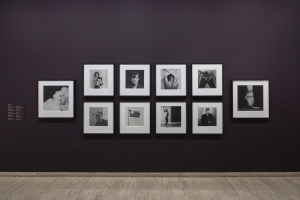Helen Ennis
The Australian modernist photographer Max Dupain is commonly known for his sweltering photograph Sunbaker, which offered the nation one of its most iconic beach images. In today’s episode, Helen Ennis reads her essay ‘Max Dupain’s dilemmas’, which was commended in the 2021 Calibre Essay Prize. It explores the breadth of Dupain’s work beyond Sunbaker, as well as his own grapplings with self-doubt and his complicated perspectives on life and travel.
Helen Ennis is Emeritus Professor at the ANU Centre for Art History and Art Theory and a past ABR Fellow. She is an independent photography curator and writer specialising in the area of Australian photographic practice. She is currently writing a biography of Max Dupain.
... (read more)Max Dupain, one of Australia’s most accomplished photographers, was filled with self-doubt. He told us so – repeatedly – in public commentary, especially during the 1980s, in the last years of his life. It is striking how candid he was, how personal, verging on the confessional, and how little attention we paid to what he said, either during his lifetime or since (he died in 1992, aged eighty-one).
... (read more)Alison Stieven-Taylor reviews 'Olive Cotton: A life in photography' by Helen Ennis
A lover of photography since childhood, by the time Olive Cotton, who was born in Sydney in 1911, was in her twenties she was already creating the pictures that were to define her as one of Australia’s foremost women photographers, although this would not be acknowledged until the 1980s. Apart from the photographs she made, Cotton left little material trace of a life that spanned nine decades (she died in 2003). This lack of physical evidence presented a challenge for biographer Helen Ennis, a former curator of photography at the National Gallery of Australia and an art historian, who has nonetheless managed to weave a compelling, if at times diaphanous, narrative.
... (read more)Helen Ennis reviews 'Vivian Maier: A Photographer’s Life and Afterlife' by Pamela Bannos
Vivian Maier has received the kind of attention most photographers and artists can only dream of – multiple monographs, documentary films, commercial gallery representation, extraordinary public interest, and now a biography. However, all this activity and acclaim has occurred posthumously. In her lifetime ...
... (read more)Robert Mapplethorpe: the perfect medium (Art Gallery of New South Wales)
This exhibition has a clear aim – to prove that Robert Mapplethorpe ‘is among the most significant artist of his time’. The evidence marshalled by the curators at the Los Angeles Country Museum of Art and the J. Paul Getty Museum is substantial. They have conducted extensive research, sourced outstanding vintage prints ...
... (read more)Helen Ennis reviews 'Lives of the Great Photographers' by Juliet Hacking
One of the big attractions of this book is the portraits and self-portraits of the photographers who are its subject. Diane Arbus, in the early stages of pregnancy, looks whimsically at her reflection in a full-length mirror; Robert Mapplethorpe's face leaps out of the darkness, paired with his skull-topped walking stick; Margaret Bourke-White perches with her camer ...
On the door to Olive Cotton’s room there is a Dymo-tape label with the name ‘N. Boardman’. Boardman has no relevance whatsoever to Olive’s life story. His name is there because Olive and her husband Ross McInerney’s home – what they always called the ‘new house’ – was previously a construction workers’ barracks. Boardman was one of the occupants, along with Ken Livio and Chris Parris, whose names appear on the doors to adjacent rooms. Olive and Ross, who lived in the ‘new house’ for nearly thirty years, never removed the labels or modified their bedrooms, bathroom, or living areas. This fascinates and perplexes me. Why wouldn’t you erase the signs of those who lived there before you? Why keep them in your most personal, intimate space, your home? What does it mean to live like this? These questions are part of a much larger set arising from my desire to better understand Olive’s life and work, especially during the years when she and Ross lived in country New South Wales, mostly on the property they named ‘Spring Forest’. For much of this time, Olive was invisible to the photography world.
... (read more)Kerryn Goldsworthy wins the Pascall Prize
Advances was delighted to learn that Kerryn Goldsworthy has won the 2013 Pascall Prize ‘Critic of the Year’. Dr Goldsworthy is a frequent contributor to, and former Editor of, ABR; she reviews Lionel Shriver’s new novel in this issue.
... (read more)Helen Ennis reviews 'Henri Cartier-Bresson: The Modern Century' by Peter Galassi
Everyone, I suspect, has a favourite photograph by Henri Cartier-Bresson. Mine shows two couples picnicking beside what I have always thought was the Marne River but turns out to be somewhere else altogether. Juvisy (1938), as it is now titled, depicts urban workers relaxing near a man-made pond in the suburbs of Paris. This is indicative of the exhaustive research of Peter Galassi and his colleagues, who have brought to light a huge amount of new information on Cartier-Bresson and his photographs. Their book has been published to accompany a Cartier-Bresson exhibition at the Museum of Modern Art, New York, where Galassi is chief curator of photography.
... (read more)Helen Ennis reviews 'Images of the Interior: Seven Central Australian Photographers' by Philip Jones
One section on Australian photography slowly growing on my bookshelves is devoted to anthropological and ethnographic photography. Philip Jones’s latest book, Images of the Interior: Seven Central Australian Photographers, belongs there because of the amount of anthropological material it contains. But it could also take its place among books devoted to vernacular photography, because none of the seven photographers Jones has selected was professionally trained. All were keen amateur photographers who produced substantial bodies of work during the time they lived and worked in Central Australia. The book deals with an epoch of dramatic change, beginning in the 1890s with some of the earliest European photographs of the Centre, and concluding in the 1940s.
... (read more)







